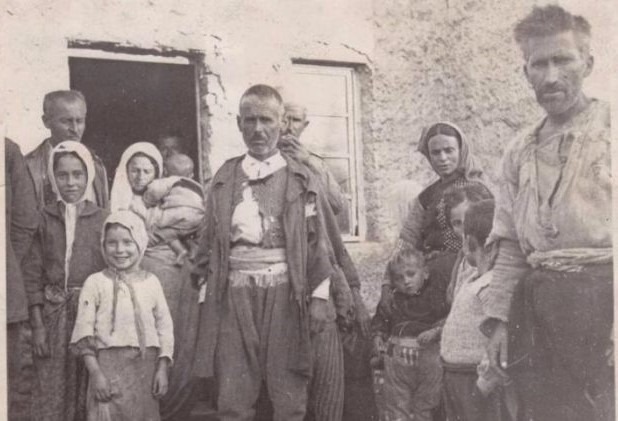By Ilir Ademi

“If you want peace, work for justice”
– Pope John Paul VI
June 27th 2019 marked the 75th anniversary of the Chameria Genocide in Paramithia, where the most brutal war crimes were also witnessed and reported by European and international humanitarian officials. Although many court and military documents related to intentional systematic massacres were destroyed by Greece during and after the genocide, documentary sources in the government archives of Greece, Albania, the UK and US are available to the Cham community.
In 1944-1945, approximately 30,000 ethnic Albanians, an officially recognized minority by Greece since 1913, were expelled from Chameria a region in northern Greece. Thousands of Chams died at the Greek-Albanian border after fleeing their ancestral homelands. According to the Chameria Patriotic Association over 2,900 died in on the way to Albania and were buried in mass graves, which to this day are visited by descendants.
Currently about 300,000 Albanians of Cham origin live in Albania. In 1994, the Albanian Parliament decreed June 27th as the annual anniversary of the Cham genocide, which the Greek state denies. In 2013, a resolution was ratified by the Parliament requiring the government of Albania to put the issue into its diplomatic agenda and try to find a solution with Greece. However, the two countries have not publicly admitted to discussing the Cham issue, a serious and sensitive political topic for both countries, as the Greek Ministry of Foreign Affairs has denied that the issue has been on the agenda. As Albania and Greece seek to solve long-standing dispute, today the Cham issue remains a sore point for the two countries.
Adding more complexity, both Albania and Greece are NATO members and are still in a state of war since Greece declared war against Albania in 1940. The conflict between the two countries, began in 1940 when the Italian forces, based in Albania after Mussolini invaded Albania in 1939, attacked Greece. For months, Greeks and Italians fought on Albanian soil. As a result, the reigning Greek king at that time, George II, issued a royal decree and declared war against Albania that resulted in the seizure of Albanian-owned property in Greece. Concurrently hundreds of civilian Albanian Chams were deported en masse to the Greek islands and suffered tortures, death and dissapearances. Politicians in both countries have agreed that the decision is absurd, but yet it somehow is still in force. Although Greece and Albania signed a friendship treaty in 1996, the Greek war decree has also been an impediment to the Albanians who once lived in Greece to seek their property rights in that country.
Cham Demands
Today, Cham Albanians request a solution for the properties that they left behind in Chameria, as well the right of Greek citizenship that they were stripped of in the 1950s by the communist regime in Albania. Chams also demand a pardon for the genocide and ethnic cleansing committed against the population in the summer of 1944 by the forces of Napoleon Zervas, the founder and the leader of the British-backed Greek movement called the National Republican Greek League, EDES.
Definitions: Genocide, Ethnic Cleansing or both?
While there exists scholarly debate on what constitutes the distinguishing factors between ethnic cleansing and genocide generally ethnic cleansing is a component of and a means to achieve genocide.
The UN General Assembly Resolution 47/121 referred in its Preamble to ‘the abhorrent policy of “ethnic cleansing”, which is a form of genocide’, as being carried on in Bosnia and Herzegovina. … It [i.e., ethnic cleansing] can only be a form of genocide within the meaning of the [Genocide] Convention, if it corresponds to or falls within one of the categories of acts prohibited by Article II of the Convention.
As the Nuremberg trials had ended, in December 11th 1946, the United Nations General Assembly Resolution 96 (I) states: “Genocide is a denial of the right of existence of entire human groups, as homicide is the denial of the right to live of individual human beings; such denial of the right of existence shocks the conscience of mankind, …and is contrary to moral law and to the spirit and aims of the United Nations. … The General Assembly, therefore, affirms that genocide is a crime under international law…whether the crime is committed on religious, racial, political or any other grounds…”
In 1948, dozens of UN member states signed the Convention on the Prevention and Punishment of the Crime of Genocide (CPPCG); Greece also was a signatory party on December 29th 1949, and ratified this CPPCG on December 8th 1954.
The definition of the crime of genocide in Article II of the Genocide Convention of 1948 has the same terms as in the Genocide Convention in the Rome Statute of the International Criminal Court (Article 6), as well as in the statutes of other international and hybrid jurisdictions. Many UN member states have also criminalized genocide in their domestic law; others have yet to do so. The CCPCG establishes in Article I the obligation of the contracting parties to prevent and to punish the crime of genocide. Article II of the CCPCG contains a narrow definition of the crime of genocide, which includes two main elements:
- A mental element: the “intent to destroy, in whole or in part, a national, ethnical, racial or religious group, as such”; and
- A physical element, which includes the following five acts, enumerated exhaustively. Further, genocide means any of the following acts committed with intent to destroy, in whole or in part, a national, ethnical, racial or religious group, as such:
- Killing members of the group;
- Causing serious bodily or mental harm to members of the group;
- Deliberately inflicting on the group conditions of life calculated to bring about its physical destruction in whole or in part;
- Imposing measures intended to prevent births within the group;
- Forcibly transferring children of the group to another group.”
To constitute genocide, there must be a proven intent on the part of perpetrators to physically destroy a national, ethnical, racial or religious group. Cultural destruction does not suffice, nor does an intention to simply disperse a group. It is this special intent, or dolus specialis, that makes the crime of genocide so unique. It is quite clear that the acts covered by the CCPCG could be encompassed under the definition of other international crimes either as crimes against humanity or war crimes. The Cham community possesses significant documents that point to organizational plans and policies to physically destroy Ethnic Albanians of Chameria a recognized national minority. The special intent, or dolus specialis, that makes the crime of genocide unique is that both Cham Albanian religious communities have been affected by the crime of genocide.
Although many court and military documents related to intentional systematic massacres were destroyed by Greece during and after the genocide, documentary sources in the government archives of Greece, Albania, the UK and US already provide sufficient information to prove that what befell the Albanians from in 1913-1945 constituted a systematic genocide. Most importantly, Albanian survivor accounts as well as Albanian and Greek historians point to available material sources from British, Australian and Italian records supporting the Chameria Genocide thesis.
The International Criminal Tribunal for the former Yugoslavia (ICTY) and the International Court of Justice (ICJ) have featured in these debates and have been found to be important tools for reconciliation being accessed through justice, since they provide an irrefutable historic record, punish the perpetrators for the sake of justice and deterrence, and promote peace and reconciliation.
The victims of genocide were not only targeted deliberately but as a whole group, not as individual members. Genocide was also committed against a substantial and identifiable group which today are known as Arvanites. According to the CCPCG a “crime against humanity” means any of the following acts when committed as part of a widespread or systematic attack directed against any civilian population, with knowledge of the attack:
| Listing of “Crimes Against Humanity” in Chameria Against Ethnic Albanians | Documents Available | Documentary Sources |
| (a) Murder; | YES | Perpetrator testimonies, government documents, victim testimonies, eyewitness accounts, photos, media etc. |
| (b) Extermination; | YES | Perpetrator testimonies, government documents, victim testimonies, eyewitness accounts, photos, media etc. |
| (c) Enslavement; | YES | Perpetrator testimonies, Victims, eyewitness accounts, media |
| (d) Deportation or forcible transfer of population; | YES | Perpetrator testimonies, government documents, victim testimonies, eyewitness accounts, photos, media etc. |
| (e) Imprisonment or other severe deprivation of physical liberty in violation of fundamental rules of international law | YES | Perpetrator testimonies, government documents, victim testimonies, eyewitness accounts, photos, media etc. |
| (f) Torture; | YES | Perpetrator testimonies, government documents, victim testimonies, eyewitness accounts, photos, media etc. |
| (g) Rape, sexual slavery, enforced prostitution, forced pregnancy, enforced sterilization, or any other form of sexual violence of comparable gravity; | YES | Perpetrator testimonies, victim testimonies, eyewitness accounts, media |
| (h) Persecution against any identifiable group or collectivity on political, racial, national, ethnic, cultural, religious, gender as defined in paragraph 3, or other grounds that are universally recognized as impermissible under international law, in connection with any act referred to in this paragraph or any crime within the jurisdiction of the Court; | YES | Perpetrator testimonies, government documents, victim testimonies, eyewitness accounts, photos, media etc. |
| (i) Enforced disappearance of persons; | YES | Perpetrator testimonies, government documents, victim testimonies, eyewitness accounts, photos, media etc. |
| (j) The crime of apartheid; | NO | N/A |
| (k) Other inhumane acts of a similar character intentionally causing great suffering, or serious injury to body or to mental or physical health. | YES | Perpetrator testimonies, government documents, victim testimonies, eyewitness accounts, photos, media etc. |
Finally, as the Greek government and military continues to deny the genocide and insinuate that the cleansing of Chameria was justified by fabricating history, the Albanian community continues to insist upon its natural human rights. Armenian-American historian and professor emeritus at UCLA, Richard G. Hovannisian defines this occurrence of genocide denial as the final stage of a genocidal process and the erasing of the memories of the victim group: “Following the physical destruction of a people and their material culture, memory is all that is left and is targeted as the last victim. Complete annihilation of a people requires the banishment of recollection and suffocation of remembrance. Falsification, deception and half-truths reduce what was to what might have been or perhaps what was not at all.”
A lasting peace with Greece cannot be guaranteed without solving the issue of the Chams, who to this day seek apology and reparation. Although the EU is also interested in the discussions, pushing for the candidate country to solve its historical disputes before joining the union, this organization has not played any role in mediating these matters.
Sources:
Dervishi, Kastriot “Massacres in Chameria” Survivors’ Testimonies. Summary of Archival Documentation (2009)
European Court of Human Rights Jorgic v. Germany §45 citing Bosnia and Herzegovina v. Serbia and Montenegro.
Hovannisian, Richard G. “Denial of the Armenian Genocide in Comparison with Holocaust Denial”. Remembrance and Denial: The Case of the Armenian Genocide. Wayne State University Press. p. 202. (1998)
United Nations Convention on the Prevention and Punishment of the Crime of Genocide. https://www.un.org/
